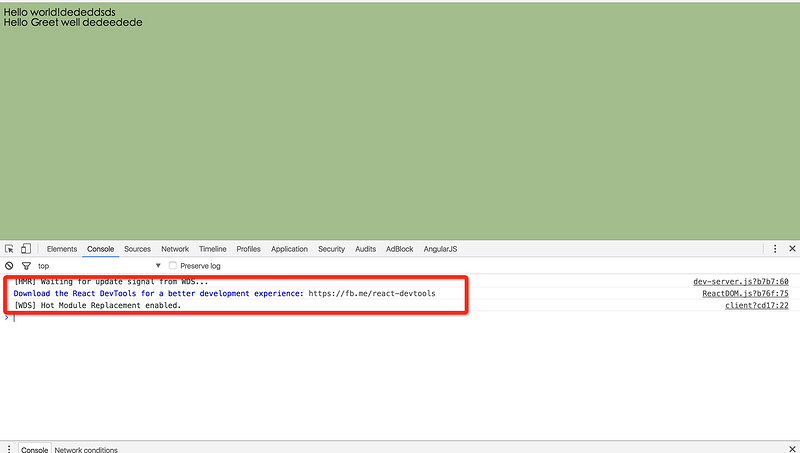记录下webpack-dev-server的用法.
首先,我们来看看基本的webpack.config.js的写法
module.exports = {
entry: './src/js/index.js',
output: {
path: '.https://img.qb5200.com/download-x/dist/js',
filename: 'bundle.js'
}
}
配置文件提供一个入口和一个出口,webpack根据这个来进行js的打包和编译工作。虽然webpack提供了webpack --watch的命令来动态监听文件的改变并实时打包,输出新bundle.js文件,这样文件多了之后打包速度会很慢,此外这样的打包的方式不能做到hot replace,即每次webpack编译之后,你还需要手动刷新浏览器。
webpack-dev-server其中部分功能就能克服上面的2个问题。webpack-dev-server主要是启动了一个使用express的Http服务器。它的作用主要是用来伺服资源文件。此外这个Http服务器和client使用了websocket通讯协议,原始文件作出改动后,webpack-dev-server会实时的编译,但是最后的编译的文件并没有输出到目标文件夹,即上面配置的:
output: {
path: '.https://img.qb5200.com/download-x/dist/js',
filename: 'bundle.js'
}
注意:你启动webpack-dev-server后,你在目标文件夹中是看不到编译后的文件的,实时编译后的文件都保存到了内存当中。因此很多同学使用webpack-dev-server进行开发的时候都看不到编译后的文件
下面来结合webpack的文档和webpack-dev-server里部分源码来说明下如何使用:
启动
启动webpack-dev-server有2种方式:
cmd lineNode.js API配置
我主要讲解下cmd line的形式,Node.js API形式大家去看下官方文档。可通过npm script进行启动。我的目录结构是:
app |__dist | |__styles | |__js | |__bundle.js | |__index.html |__src | |__styles | |__js | |__index.js |__node_modules |__package.json |__webpack.config.js
content-base
设定webpack-dev-server伺服的directory。如果不进行设定的话,默认是在当前目录下。
webpack-dev-server --content-base .https://img.qb5200.com/download-x/dist
这个时候还要注意的一点就是在webpack.config.js文件里面,如果配置了output的publicPath这个字段的值的话,在index.html文件里面也应该做出调整。因为webpack-dev-server伺服的文件是相对publicPath这个路径的。因此,如果你的webpack.config.js配置成这样的:
module.exports = {
entry: './src/js/index.js',
output: {
path: '.https://img.qb5200.com/download-x/dist/js',
filename: 'bundle.js',
publicPath: '/assets/'
}
}
那么,在index.html文件当中引入的路径也发生相应的变化:
<!DOCTYPE html>
<html lang="en">
<head>
<meta charset="UTF-8">
<title>Demo</title>
</head>
<body>
<script src="assets/bundle.js"></script>
</body>
</html>
如果在webpack.config.js里面没有配置output的publicPath的话,那么index.html最后引入的文件js文件路径应该是下面这样的。
<!DOCTYPE html>
<html lang="en">
<head>
<meta charset="UTF-8">
<title>Demo</title>
</head>
<body>
<script src="bundle.js"></script>
</body>
</html>
Automatic Refresh
webpack-dev-server支持2种自动刷新的方式:
这2种模式配置的方式和访问的路径稍微有点区别,最主要的区别还是Iframe mode是在网页中嵌入了一个iframe,将我们自己的应用注入到这个iframe当中去,因此每次你修改的文件后,都是这个iframe进行了reload。
通过查看webpack-dev-server的源码,lib路径下的Server.js文件,第38-48行,分别新建几个流,这几个流保存了client文件夹下的相关文件:
// Prepare live html page var livePage = this.livePage = new StreamCache(); fs.createReadStream(path.join(__dirname, "..", "client", "live.html")).pipe(livePage); // Prepare the live js file var liveJs = new StreamCache(); fs.createReadStream(path.join(__dirname, "..", "client", "live.bundle.js")).pipe(liveJs); // Prepare the inlined js file var inlinedJs = new StreamCache(); fs.createReadStream(path.join(__dirname, "..", "client", "index.bundle.js")).pipe(inlinedJs);
// Init express server
var app = this.app = new express();
// middleware for serving webpack bundle
this.middleware = webpackDevMiddleware(compiler, options);
app.get("/__webpack_dev_server__/live.bundle.js", function(req, res) {
res.setHeader("Content-Type", "application/javascript");
liveJs.pipe(res);
});
app.get("/webpack-dev-server.js", function(req, res) {
res.setHeader("Content-Type", "application/javascript");
inlinedJs.pipe(res);
});
app.get("/webpack-dev-server/*", function(req, res) {
res.setHeader("Content-Type", "text/html");
this.livePage.pipe(res);
}.bind(this));
当使用Iframe mode时,请求/webpack-dev-server/index.html路径时,会返回client/index.html文件,这个文件的内容就是:
<!DOCTYPE html><html> <head> <meta http-equiv="X-UA-Compatible" content="IE=edge"/> <meta charset="utf-8"/> <meta name="viewport" content="width=device-width, height=device-height, initial-scale=1.0, user-scalable=no, minimum-scale=1.0, maximum-scale=1.0"/> <script type="text/javascript" charset="utf-8" src="/__webpack_dev_server__/live.bundle.js"> </script> </head> <body></body> </html>
这个页面会请求live.bundle.js,其中里面会新建一个Iframe,你的应用就被注入到了这个Iframe当中。同时live.bundle.js中含有socket.io的client代码,这样它就能和webpack-dev-server建立的http server进行websocket通讯了。并根据返回的信息完成相应的动作。
而Inline-mode,是webpack-dev-server会在你的webpack.config.js的入口配置文件中再添加一个入口,
module.exports = {
entry: {
app: [
'webpack-dev-server/client?http://localhost:8080/',
'./src/js/index.js'
]
},
output: {
path: '.https://img.qb5200.com/download-x/dist/js',
filename: 'bundle.js'
}
}
这样就完成了将inlinedJS打包进bundle.js里的功能,同时inlinedJS里面也包含了socket.io的client代码,可以和webpack-dev-server进行websocket通讯。
当然你也可以直接在你index.html引入这部分代码:
<script src="http://localhost:8080/webpack-dev-server.js"></script>
不过Iframe mode和Inline mode最后达到的效果都是一样的,都是监听文件的变化,然后再将编译后的文件推送到前端,完成页面的reload的。
Iframe mode
Iframe mode下cmd line不需要添加其他的内容,浏览器访问的路径是:localhost:8080/webpack-dev-server/index.html。
这个时候这个页面的header部分会出现整个reload消息的状态。当时改变源文件的时候,即可以完成自动编译打包,页面自动刷新的功能。

Inline mode
使用inline mode的时候,cmd line需要写成:
webpack-dev-server --inline --content-base .https://img.qb5200.com/download-x/dist
这个时候访问的路径是:localhost:8080/index.html
也能完成自动编译打包,页面自动刷新的功能。但是没有的header部分的reload消息的显示,不过在控制台中会显示reload的状态。

Hot Module Replacement
开启Hot Module Replacement功能,在cmd line里面添加--hot
webpack-dev-server --hot --inline --content-base .https://img.qb5200.com/download-x/dist
其他配置选项
还有一切其他的配置信息可以查阅官方文档:
这是我的package.json的文件:
{
"name": "reptile",
"version": "1.0.0",
"description": "",
"main": "index.js",
"scripts": {
"dev": "webpack-dev-server --devtool eval-source-map --progress --colors --hot --inline --content-base .https://img.qb5200.com/download-x/dist",
"build": "webpack --progress --colors"
},
"author": "",
"license": "ISC",
"devDependencies": {
"babel-core": "^6.13.2",
"babel-loader": "^6.2.5",
"babel-preset-es2015": "^6.13.2",
"babel-preset-react": "^6.11.1",
"css-loader": "^0.23.1",
"react": "^15.3.1",
"react-dom": "^15.3.1",
"style-loader": "^0.13.1",
"webpack": "^1.13.2",
"webpack-dev-server": "^1.14.1"
}
}
首先命令行:输入 npm install 所有依赖。然后输入npm run dev。在浏览器中打开localhost:8080/index.html,然后就可以愉快的开发咯。
本地搭建API Server
如果你在本地还启动了一个api server,port为3000,这个server主要和你的前端应用进行数据交互。这个时候很显然会出现跨域的问题,那么这个时候,你前端应用的入口文件应当是用你自己启动的api server提供的。
var express = require('express');
var app = express();
app.get('/', function(req, res) {
res.send('xxx/xxx/index.html'); //这个地方填写dist/index.html的路径
})
此外webpack.config.js:
module.exports = {
entry: './src/js/index.js',
output: {
path: '.https://img.qb5200.com/download-x/dist/js',
filename: 'bundle.js',
publicPath: 'localhost:8080https://img.qb5200.com/download-x/dist'
},
devServer: {
'/get': {
targer: 'localhost:3000',
secure: false
}
}
}
将publicPath字段的内容配置为绝对路径。同时index.html文件中对js引用的路径也改为绝对路径
<script src="localhost:8080https://img.qb5200.com/download-x/dist/bundle.js"></script>
如果对web-dev-server还有其他问题的话,请留言告知。
另外2篇关于webpack的文章: